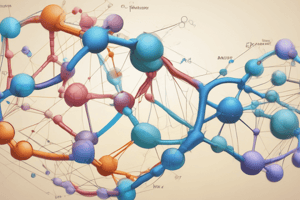Podcast
Questions and Answers
What is the first purine derivative formed in nucleotide metabolism?
What is the first purine derivative formed in nucleotide metabolism?
- Xanthine Monophosphate (XMP)
- Guanosine Monophosphate (GMP)
- Adenosine Monophosphate (AMP)
- Inosine Monophosphate (IMP) (correct)
Where do the carbon and nitrogen atoms of the purine ring come from?
Where do the carbon and nitrogen atoms of the purine ring come from?
- Exclusively from glutamine
- Exclusively from glycine
- From multiple sources including glycine, glutamine, and aspartic acid (correct)
- Exclusively from aspartic acid
What is the key regulatory step in purine nucleotide synthesis?
What is the key regulatory step in purine nucleotide synthesis?
- Formation of adenosine monophosphate (AMP)
- Production of 5-phospho-αD-ribosyl 1-pyrophosphate (PRPP) (correct)
- Formation of guanosine monophosphate (GMP)
- Synthesis of inosine monophosphate (IMP)
What activates the production of 5-phospho-αD-ribosyl 1-pyrophosphate (PRPP)?
What activates the production of 5-phospho-αD-ribosyl 1-pyrophosphate (PRPP)?
Flashcards are hidden until you start studying
Study Notes
Purine Metabolism Basics
- The first purine derivative formed in nucleotide metabolism is inosine monophosphate (IMP).
- This molecule serves as the precursor for both adenine and guanine nucleotides.
Source of Atoms in Purine Ring
- Carbon and nitrogen atoms of the purine ring are derived from several sources:
- Aspartate and glycine contribute nitrogen atoms.
- Carbon dioxide (CO2) provides a carbon atom.
- Other carbon atoms originate from tetrahydrofolate derivatives.
Regulatory Step in Synthesis
- The key regulatory step in purine nucleotide synthesis is the conversion of PRPP to 5-phosphoribosylamine, catalyzed by the enzyme amidophosphoribosyl transferase.
- This reaction is crucial for controlling the flow of metabolites through the purine synthesis pathway.
Activation of PRPP Production
- The production of 5-phospho-αD-ribosyl 1-pyrophosphate (PRPP) is activated by inorganic phosphate (Pi) and ATP.
- PRPP acts as a substrate for several biosynthetic pathways, including nucleotide synthesis, and is essential for the production of nucleotides.
Studying That Suits You
Use AI to generate personalized quizzes and flashcards to suit your learning preferences.




